Powergel 2.5%W/W Gel
Out of date information, search another2391
05.09.12[3]
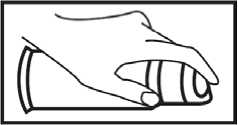
PATIENT INFORMATION LEAFLET
Powergel® 2.5 %w/w Gel
(Ketoprofen)
This medicine is available using above name but will be referred to as Powergel throughout this leaflet.
Read all of this leaflet carefully before you start using this medicine.
• Keep this leaflet. You may need to read it again.
• If you have any further questions, ask your doctor or pharmacist.
• This medicine has been prescribed for you. Do not pass it on to others. It may harm them, even if their symptoms are the same as yours.
• If any of the side effects gets serious, or if you notice any side effects not listed in this leaflet, please tell your doctor or pharmacist.
In this leaflet:
1. What Powergel is and what it is used for
2. Before you use Powergel
3. How to use Powergel
4. Possible side effects
5. How to store Powergel
6. Further information
1. What Powergel is and what it is used for
Powergel contains a medicine called ketoprofen. Powergel belongs to a group of medicines called Non-Steroidal Anti- Inflammatory Drugs (NSAIDs). These reduce inflammation and relieve pain.
Powergel is used to relieve the pain of soft tissue injuries, and acute strains and sprains. Powergel should only be used by adults and children over 12 years of age.
2. Before you use Powergel
Do not use Powergel and tell your doctor if:
• you are hypersensitive (allergic) to the active substance ketoprofen, UV blockers (sun creams) or perfumes
• you are hypersensitive (allergic) to any of the other ingredients of Powergel (see Section 6, “Further information” for a list of other ingredients)
• you are hypersensitive (allergic) to aspirin, other NSAIDs (eg ibuprofen) or any medicines for pain relief or inflammation including tiaprofenic acid
• you are hypersensitive to fenofibrate (a medicine used to lower blood cholesterol)
• you have had wheezing (asthma), runny nose (rhinitis) or an itchy rash (hives) after taking aspirin or other NSAIDs (eg ibuprofen)
• you intend to use it on an open wound, abscess, ulcer or tumour
• the area to be treated is near the eyes.
Stop using Powergel immediately if you experience any skin reaction including reactions after co-application with octocrylene containing products (octocrylene is an ingredient used in several cosmetic and hygiene products such as shampoo, aftershave, shower and bath gels, skin creams, lipsticks, anti-ageing creams, make-up removers and hair sprays in order to delay product breakdown due to sunlight).
Protect your skin from sunlight even on a bright but cloudy day. Do not use sunbeds. This applies during treatment and for two weeks after stopping.
Take special care with Powergel
• If you have kidney problems, talk to your doctor before using Powergel.
• Exposure to the sun (even hazy) or to UV from a sunbed or solarium of areas treated with Powergel can induce potentially serious skin reactions (photosensitisation). Therefore it is necessary to:
- protect treated areas by wearing clothing during treatment and for two weeks following its discontinuation to avoid any risk of photosensitisation.
- wash your hands thoroughly after each application of Powergel.
• Treatment should be discontinued immediately upon development of any skin reaction after application of Powergel.
Taking other medicines
Tell your doctor or pharmacist if you are taking or have recently taken any other medicines, e.g. oral anticoagulants (blood thinning medicines). This includes medicines you can buy without a prescription. This is because Powergel can affect the way some other medicines work. Also, some other medicines can affect the way Powergel works.
Pregnancy and breast-feeding
Do not use if you are pregnant or breast-feeding. It may affect your baby. Driving and using machines
Powergel should not affect your ability to drive and use machinery.
3. How to use Powergel How to apply Powergel
It is important to use Powergel as directed:
• tube: unscrew the cap and pierce the aluminium seal with the point in the top of the cap.
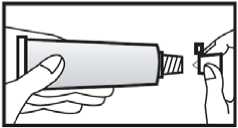
• pump dispenser: when using the pump dispenser for the first time, press the top of the dispenser several times or push the bottom until the gel is released). Keep the dispenser in a horizontal position during use (see the pictures below).
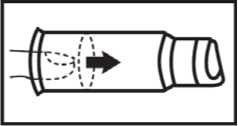
When and how much to use
Apply a length of gel 5-10 cm (2-4 inches) long (3-6 pushes of the pump dispenser) to the skin of the affected area two or three times daily.
How and where to use Powergel
• Powergel is for external use only
• Gently massage the gel on the area you need to treat
• Wash your hands immediately after use
• Do not apply Powergel to sore, broken or infected skin
• Do not use Powergel near the eyes, mouth, nostrils, anal and genital regions
• Stop using Powergel if you get a rash, itchy or sensitive skin after use
• Do not use with an air-tight or water-tight dressing (i.e. do not bandage, wrap, or cover the area with a plastic dressing)
• Do not use too much of this medicine.
Protection from the sun and sunbeds
• Do not expose the skin that has been treated with Powergel to direct sunlight or sunbeds during treatment or for the following 2 weeks.
How long should you use Powergel for?
Do not use Powergel for more than 10 days in a row.
If your symptoms persist after 10 days, tell your doctor.
If you use more Powergel than you should
When Powergel is externally applied (on the skin), very little reaches the blood. For this reason overdose effects are most unlikely.
If you have any further questions on the use of this product, ask your doctor or pharmacist.
4. Possible side effects
Like all medicines, Powergel can cause side effects, although not everybody gets them.
Stop using Powergel and tell your doctor if you notice any of the following side-effects:
• Localised allergic skin reactions such as redness, swelling, itching and blisters: in some severe cases, these might also spread beyond the area of application
• Severe skin reactions during exposure to sunlight
• Increased sensitivity of your skin to sunlight.
• Cases of more severe forms of eczema which may spread or become generalized have occurred rarely.
Other effects, which depend on the amount of gel applied, the extent of the area that is treated, skin thickness, length of treatment, and the use of an air-tight or water-tight dressing, are the following:
• Stomach ulcer, which may be bleeding, and diarrhoea
• Kidney problems (worsening of a pre-existing renal dysfunction)
• Allergic reactions, which may lead to difficulty breathing and/or may be very severe (anaphylaxis). If this occurs, seek medical aid immediately.
Other effects whose frequency is unknown but which have been reported:
• A kind of skin infection (known as impetigo)
• Higher than normal levels of eosinophils (a particular kind of blood cell)
• Hypersensitivity (a type of allergic reaction)
• Swelling of the eyelids or of the lips
• Inflammation of blood vessels (known as vasculitis)
• Loose stools
• Sensation of burning skin, inflammation of the skin with blisters, skin reactions associated with exposure to sunlight, hives, itchy skin, swelling of the skin
• Interruption of normal functioning of the kidneys
• Higher than normal body temperature
• Complication of wounds
Elderly people are generally more likely to suffer from side effects of Non Steroidal Anti-Inflammatory Drugs (the drug class to which Powergel belongs
If any of the side effects gets serious, or if you notice any side effects not listed in this leaflet, please tell your doctor or pharmacist.
5. How to store Powergel
- Keep out of the sight and reach of children.
- Do not use Powergel after the expiry date which is on the carton and tube/dispenser. The expiry date refers to the last day of that month.
- Do not store above 25°C.
- If the gel become discoloured or show any other signs of deterioration, consult your pharmacist who will tell you what to do.
- Medicines should not be disposed of via wastewater or household waste. Ask your pharmacist how to dispose of medicines no longer required. These measures will help to protect the environment.
6. Further information What Powergel contains
The active substance is ketoprofen.
Each gram of gel contains 25 mg ketoprofen.
Also contains carbomer, ethanol, lavender essential oil, diethanolamine and purified water.
What Powergel looks like and contents of the pack
Powergel is a colourless, clear gel with an aromatic fragrance available in aluminium tube with plastic screw cap or plastic pump actuated dispenser with cap.
Powergel is available in the following pack sizes -60g tube, 2 x 60g tubes and 120g pump dispenser.
Manufacturer and Product Licence Holder
Manufactured by A. Menarini Manufacturing Logistics and Services S.R.L., Via Rosolino Pilo 4, Florence, 1-50100, Italy.
Procured from within the EU by Product Licence holder:
Star Pharmaceuticals Ltd., 5 Sandridge Close, Harrow, Middlesex HA1 1XD. Repackaged by Servipharm Ltd
| POM | | PL 20636/2391
Leaflet revision and issue date (Ref) 05.09.12[3]
Powergel is a trademark of A. Menarini Industrie Farmaceutiche Riunite S.R.L.
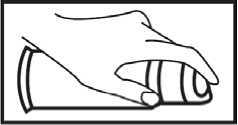
PATIENT INFORMATION LEAFLET 05 091
Ketoprofen 2.5 %w/w Gel
This medicine is available using above name but will be referred to as Ketoprofen gel throughout this leaflet.
Read all of this leaflet carefully before you start using this medicine.
• Keep this leaflet. You may need to read it again.
• If you have any further questions, ask your doctor or pharmacist.
• This medicine has been prescribed for you. Do not pass it on to others. It may harm them, even if their symptoms are the same as yours.
• If any of the side effects gets serious, or if you notice any side effects not listed in this leaflet, please tell your doctor or pharmacist.
In this leaflet:
1. What Ketoprofen gel is and what it is used for
2. Before you use Ketoprofen gel
3. How to use Ketoprofen gel
4. Possible side effects
5. How to store Ketoprofen gel
6. Further information 1. What Ketoprofen gel is and what it is used for
Ketoprofen gel contains a medicine called ketoprofen. Ketoprofen gel belongs to a group of medicines called Non-Steroidal Anti- Inflammatory Drugs (NSAIDs). These reduce inflammation and relieve pain.
Ketoprofen gel is used to relieve the pain of soft tissue injuries, and acute strains and sprains. Ketoprofen gel should only be used by adults and children over 12 years of age.
2. Before you use Ketoprofen gel
Do not use Ketoprofen gel and tell your doctor if:
• you are hypersensitive (allergic) to the active substance ketoprofen, UV blockers (sun creams) or perfumes
• you are hypersensitive (allergic) to any of the other ingredients of Ketoprofen gel (see Section 6, “Further information” for a list of other ingredients)
• you are hypersensitive (allergic) to aspirin, other NSAIDs (eg ibuprofen) or any medicines for pain relief or inflammation including tiaprofenic acid
• you are hypersensitive to fenofibrate (a medicine used to lower blood cholesterol)
• you have had wheezing (asthma), runny nose (rhinitis) or an itchy rash (hives) after taking aspirin or other NSAIDs (eg ibuprofen)
• you intend to use it on an open wound, abscess, ulcer or tumour
• the area to be treated is near the eyes.
Stop using Ketoprofen gel immediately if you experience any skin reaction including reactions after co-application with octocrylene containing products (octocrylene is an ingredient used in several cosmetic and hygiene products such as shampoo, aftershave, shower and bath gels, skin creams, lipsticks, anti-ageing creams, make-up removers and hair sprays in order to delay product breakdown due to sunlight).
Take special care with Ketoprofen gel
• If you have kidney problems, talk to your doctor before using Ketoprofen gel.
• Exposure to the sun (even hazy) or to UV from a sunbed or solarium of areas treated with Ketoprofen gel can induce potentially serious skin reactions (photosensitisation). Therefore it is necessary to:
- protect treated areas by wearing clothing during treatment and for two weeks following its discontinuation to avoid any risk of photosensitisation.
- wash your hands thoroughly after each application of Ketoprofen gel.
• Treatment should be discontinued immediately upon development of any skin reaction after application of Ketoprofen gel.
Taking other medicines
Tell your doctor or pharmacist if you are taking or have recently taken any other medicines, e.g. oral anticoagulants (blood thinning medicines). This includes medicines you can buy without a prescription. This is because Ketoprofen gel can affect the way some other medicines work. Also, some other medicines can affect the way Ketoprofen gel works.
Pregnancy and breast-feeding
Do not use if you are pregnant or breast-feeding. It may affect your baby.
Driving and using machines
Ketoprofen gel should not affect your ability to drive and use machinery.
3. How to use Ketoprofen gel How to apply Ketoprofen gel
It is important to use Ketoprofen gel as directed:
• tube: unscrew the cap and pierce the aluminium seal with the point in the top of the cap.

pump dispenser: when using the pump dispenser for the first time, press the top of the dispenser several times or push the bottom until the gel is released). Keep the dispenser in a horizontal position during use (see the pictures below).
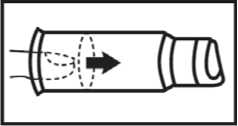
When and how much to use
Apply a length of gel 5-10 cm (2-4 inches) long (3-6 pushes of the pump dispenser) to the skin of the affected area two or three times daily.
How and where to use Ketoprofen gel
• Ketoprofen gel is for external use only
• Gently massage the gel on the area you need to treat
• Wash your hands immediately after use
• Do not apply Ketoprofen gel to sore, broken or infected skin
• Do not use Ketoprofen gel near the eyes, mouth, nostrils, anal and genital regions
• Stop using Ketoprofen gel if you get a rash, itchy or sensitive skin after use
• Do not use with an air-tight or water-tight dressing (i.e. do not bandage, wrap, or cover the area with a plastic dressing)
• Do not use too much of this medicine.
Protection from the sun and sunbeds
• Do not expose the skin that has been treated with Ketoprofen gel to direct sunlight or sunbeds during treatment or for the following 2 weeks.
How long should you use Ketoprofen gel for?
Do not use Ketoprofen gel for more than 10 days in a row.
If your symptoms persist after 10 days, tell your doctor.
If you use more Ketoprofen gel than you should
When Ketoprofen gel is externally applied (on the skin), very little reaches the blood. For this reason overdose effects are most unlikely.
If you have any further questions on the use of this product, ask your doctor or pharmacist.
4. Possible side effects
Like all medicines, Ketoprofen gel can cause side effects, although not everybody gets them.
Stop using Ketoprofen gel and tell your doctor if you notice any of the following side-effects:
• Localised allergic skin reactions such as redness, swelling, itching and blisters: in some severe cases, these might also spread beyond the area of application
• Severe skin reactions during exposure to sunlight
• Increased sensitivity of your skin to sunlight.
• Cases of more severe forms of eczema which may spread or become generalized have occurred rarely.
Other effects, which depend on the amount of gel applied, the extent of the area that is treated, skin thickness, length of treatment, and the use of an air-tight or water-tight dressing, are the following:
• Stomach ulcer, which may be bleeding, and diarrhoea
• Kidney problems (worsening of a pre-existing renal dysfunction)
• Allergic reactions, which may lead to difficulty breathing and/or may be very severe (anaphylaxis). If this occurs, seek medical aid immediately.
Protect your skin from sunlight even on a bright but cloudy day. Do not use sunbeds. This applies during treatment and for two weeks after stopping.
Other effects whose frequency is unknown but which have been reported:
• A kind of skin infection (known as impetigo)
• Higher than normal levels of eosinophils (a particular kind of blood cell)
• Hypersensitivity (a type of allergic reaction)
• Swelling of the eyelids or of the lips
• Inflammation of blood vessels (known as vasculitis)
• Loose stools
• Sensation of burning skin, inflammation of the skin with blisters, skin reactions associated with exposure to sunlight, hives, itchy skin, swelling of the skin
• Interruption of normal functioning of the kidneys
• Higher than normal body temperature
• Complication of wounds
Elderly people are generally more likely to suffer from side effects of Non Steroidal Anti-Inflammatory Drugs (the drug class to which Ketoprofen gel belongs
If any of the side effects gets serious, or if you notice any side effects not listed in this leaflet, please tell your doctor or pharmacist.
5. How to store Ketoprofen gel
- Keep out of the sight and reach of children
- Do not use Ketoprofen gel after the expiry date which is on the carton and tube/dispenser. The expiry date refers to the last day of that month.
- Do not store above 25°C.
- If the gel become discoloured or show any other signs of deterioration, consult your pharmacist who will tell you what to do.
- Medicines should not be disposed of via wastewater or household waste. Ask your pharmacist how to dispose of medicines no longer required. These measures will help to protect the environment.
6. Further information
What Ketoprofen gel contains
The active substance is ketoprofen.
Each gram of gel contains 25 mg ketoprofen.
Also contains carbomer, ethanol, lavender essential oil, diethanolamine and purified water.
What Ketoprofen gel looks like and contents of the pack
Ketoprofen gel is a colourless, clear gel with an aromatic fragrance available in aluminium tube with plastic screw cap or plastic pump actuated dispenser with cap.
Ketoprofen gel is available in the following pack sizes -60g tube, 2 x 60g tubes and 120g pump dispenser.
Manufacturer and Product Licence Holder
Manufactured by A. Menarini Manufacturing Logistics and Services S.R.L., Via Rosolino Pilo 4, Florence, 1-50100, Italy.
Procured from within the EU by Product Licence holder:
Star Pharmaceuticals Ltd., 5 Sandridge Close, Harrow, Middlesex HA1 1XD. Repackaged by Servipharm Ltd
POM
PL 20636/2391
Leaflet revision and issue date (Ref) 05.09.12[3]